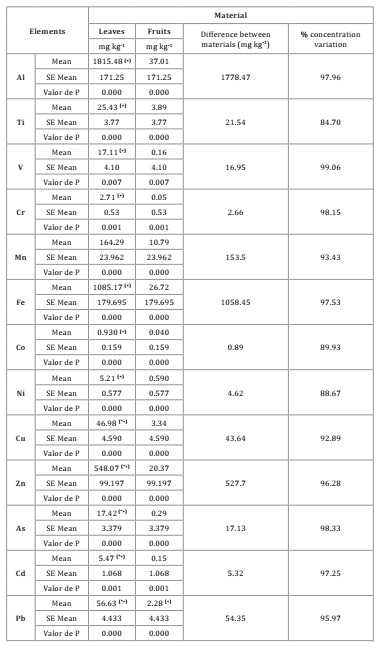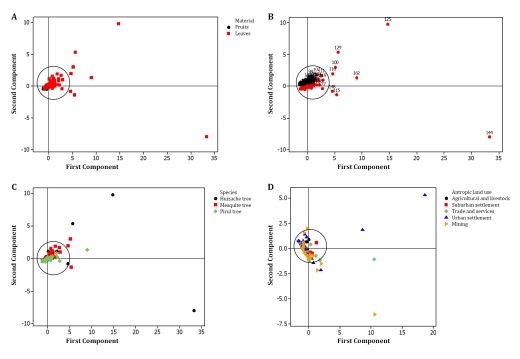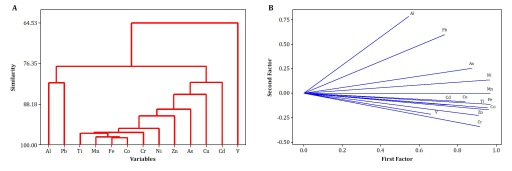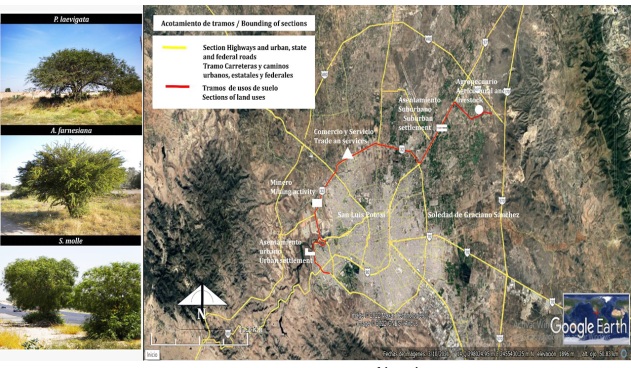Introduction
Tree species represent a potential bioindicator for studying environmental pollutants due to their ability to accumulate heavy metals. Among the ecological services provided by vegetation, microenvironmental enhancement, runoff reduction, carbon sequestration and accumulation, noise reduction, air purification, and pollutant sequestration are essential 19. Heavy metals (HM) are of interest in environmental studies, and tree species serve as bioin dicators 42. Plants have evolved mechanisms to take up and tolerate these potentially toxic elements 36. They accumulate readily and are persistent because they are not biodegradable or thermally degradable and can be toxic at high concentrations 21,32. Some oligo-elements, such as Fe, Mn, Zn, Cu, Mg, Mo, and Ni, have biological significance, while others, such as Cd, Cr, Pb, Co, Ag, Se, and Hg, are phytotoxic 18,28. Human activities such as car exhaust, industrial factories, urban waste, intensive use of fertilizers, and others 28,29 are the primary sources of emissions. Vegetation can absorb HM through roots, stems, and leaves; however, accumu lation depends on the specific metal element, plant species, and environmental conditions 15,19. In addition, HM exhibits different behavior and mobility patterns in the plant, with some tending to immobilize and accumulate in the roots, while others migrate to the aboveground organs 15. In different regions of the world, interest in the study of HM is based on biological and phytogeographical characteristics of urban trees 19,30.
In Mexico, anthropogenic activity, especially mining, is thought to have increased, contaminating with HM such as Hg, As, Pb, and Cr 17. San Luis Potosi (Mx) has sites contaminated with As and Pb 21. In the urban and suburban areas of San Luis Potosi and Graciano Sanchez, atmospheric particles contaminated with Fe, Pb, Cr, Mn, Ni, Cu, Cd, As, and Ti, among others, were found in soils, river sediments, and leaves and bark of trees 5,6,7,8,9, 12,35. These data demonstrate the environmental impact of habitat fragmentation due to soil diversification and urban-industrial activities. The study is focused mainly on determining the concentrations of HM in plants, and in some cases, their hyperaccumu lation potential was highlighted. However, there is a need to investigate the effects of HM on plant populations and the associated impacts on ecosystems and genetic and biological diversity 25. This work aimed to examine metallic elements in fruits and leaves of three common tree species in the urban area of San Luis Potosi (Mx).
Material and methods
The study area is located in the state of San Luis Potosi, in the urban-suburban area of the municipalities of San Luis Potosi (22°09’05” North, 100°58’37 West, 18640 m a.s.l.) and Soledad de Graciano Sanchez (22°11’16” North, 100° 56’ 14” West, 1850 m a.s.l.) 23. The climate is semiarid (BS1k), very arid (BWk), and very dry semiarid (BWh), with an annual rainfall of 400-500 mm. The predominant soils are Vertisols, Durisol, and Leptosol 23. According to the urban and suburban dynamics between the cities of San Luis Potosí and Soledad de Graciano Sanchez, a road route was established and defined by the influence of five land uses, agriculture, urban development, commerce, services, and mining. For each land use, six points were determined considering the presence of the three tree species: Prosopis laevigata L. Willd. (Mesquite), Acacia farnesiana L. Willd. (Huizache) and Schinus molle L. (Pirul). Trees aligned along the road, considering a maximum distance of 10 m between individuals of each species. A total of 90 leaves and 90 fruit samples (30 for each material and tree species), with an average weight of about 50 g, were randomly selected on the left and right sides of branches with a height of 1.60 to 1.80 m. The samples were collected in July and August 2018 (Figure 1).
The collected material was washed with distilled water and dried in an oven at 60°C. From each collected material, 1 g was calcined to triplicate at 450° C, then the niter extract was prepared (nitric acid 1%) and filtered. The following elements were analyzed: Al, Ti, V, Cr, Mn, Fe, Co, Ni, Cu, Zn, As, Cd, and Pb using the ICP-MS (inductively coupled plasma mass spectrometry) 5,6,7,8,9,40. All the analyses were performed in the laboratories of Environmental Engineering and the Institute of Geology (UASLP, Mx). The results were expressed in mg kg-1 dry weight. In addition, the concentrations of HM in the leaves and fruits were used to calculate the difference between materials (mg kg-1 in dry weight) and the percentage variation in concentration between species. Data were statistically analyzed using ANOVA and Pearson correlation coefficient (α≤0.05), including interactions among factors of soil use, species, and biological material (leaves and fruits). In addition, principal component analysis was performed considering 13 HM. All analyses were performed using MINITAB 16® statistical software.
Results and discussion
13 HM, evaluated in 180 samples, showed an average concentration ratio in leaves and fruits of the three tree species (mg kg-1 dry weight) oscillated at the ratio of Al > Fe > Zn > Mn > Pb > Cu > Ti > As > V > Ni > Cd > Cr > As. Correlation analysis revealed that 78 inter actions were positively significant (p≤0.05, Table 1).
Table 1: Significant relations of the Pearson correlation coefficient in metallic elements assessed in leaves and fruits material of trees of the three species (p≤0.05, n=180). Tabla 1: Relaciones significativas del coeficiente de correlación de Pearson en elementos metálicos evaluados en hojas y frutos de árboles de las tres especies (p≤0,05, n=180).

Of these, the highest values were for Co-Fe (r=0.979), Co-Mn (r=0.976), and Fe-Mn (r=0.973).
The analysis of ANOVA showed no significant effect on the concentrations of HM in the leaves and fruits of the trees when the impact of land use was taken into account. However, the influence of tree species significantly affected only three HM of the 13 HM identified. In both cases, the non-significant and significant results indicate concentrations considered adequate or regular, toxic or excessively toxic according to various technical sources (Table 2 and Table 3, page 65).
Table 2: Ratio of average concentrations of metal elements in fruits and leaves of the three tree species as a function of land use and reference values for normal and toxic levels (n=180). Tabla 2: Relación de concentraciones medias de elementos metálicos en frutos-hojas de las tres especies arbóreas según los usos de suelo y referencia de niveles normales y tóxicos (n=180).

(*) The Site and Soil Characterization Guide for Hazardous Waste Sites considers excessive or toxic areas in various plants 14. (+) The Trace Element Handbook 24 considers reference concentrations in multiple plants. NA. Data not available
(*) Guía de Descripción de Sitios y Suelos para la Caracterización de Sitios de Residuos Peligrosos considera rangos excesivos o tóxicos en varias plantas 14. (+) El manual de Oligoelementos 24 considera concentraciones de referencia en varias plantas. NA. Dato no disponible.
Table 3: Ratio of concentrations of non-significant metallic elements in leaves and fruits according to tree species and reference of average and phytotoxic values (n=180). Tabla 3: Relación de concentraciones no significativas de elementos metálicos en hojas y frutos según especie arbórea y referencia de niveles normales y fitotóxicos (n=180).

(*) The Site and Soil Characterization Guide for Hazardous Waste Sites considers excessive or toxic areas in various plants 14. (+) The Trace Element Handbook 24 considers reference concentrations in multiple plants. NA. Data not available
(*) La Guía de Descripción de Sitios y Suelos para la Caracterización de Sitios de Residuos Peligrosos considera rangos excesivos o tóxicos en varias plantas 14. (+) El manual de Oligoelementos 24 considera concentraciones de referencia en varias plantas. ND. Dato no disponible. NA. Dato no disponible.
Regarding the non-significant concentrations of HM in the leaves and fruits of the samples from the different land use types, it is noticeable that the mean concentrations of As, Cu, Pb, Zn, V, and Fe are above the values considered sufficient or regular, toxic or excessively toxic (Table 2, page 65). Likewise, it is noted that the mean concentrations of Co, Ni, Ti, Cr, Mn, and Fe in leaf material and fruits were higher in samples with urban use; and V, Cu, Zn, and Cd in samples with mining-industrial land use, in cases with phytotoxic levels 14,15,16,24. Regarding the presence of Al and Pb, concentrations were higher in suburban land use, and As was more elevated in leaf and fruit samples from trees in agricultural land use. Similar studies using leaf material of the same species found that the concentrations of As, Co, and Pb were higher in trees located on mining land 6. Comparing the concentrations of the 13 elements in leaf and fruit samples of the three tree species studied, the effect was not-significant for Al, Ti, V, Zn, Cr, Mn, Fe, Ni, Cu, and Cd (Table 3, page 65). For Co, As, and Pb, the significant concen trations depended on the tree species (Table 4, page 66).
Table 4: Ratio of significant Co, As, and Pb concentrations in three studied trees (p≤0.05). Tabla 4: Relación de concentraciones significativas de Co, As y Pb en las tres especies de árboles (p≤0,05).

(*) The Site and Soil Characterization Guide for Hazardous Waste Sites considers excessive or toxic areas in various plants 14. (+) The Trace Element Handbook 24 considers reference concentrations in multiple plants.
(*) La Guía de Descripción de Sitios y Suelos para la Caracterización de Sitios de Residuos Peligrosos considera rangos excesivos o tóxicos en varias plantas 14. (+) El manual de Oligoelementos 24 considera concentraciones de referencia en varias plantas.
First, it is noticeable that the ratio of the average concentrations of the metallic elements in the three tree species in leaves in the order Al > Fe > Zn > Mn > Pb > Cu > Ti > As > V > Cd > Ni > Cr > Co and in fruits Al > Fe > Zn > Mn > Ti > Cu > Pb > Ni > As > V > Cd > Cr > Co.
For the ten HM, where the concentrations presented in Table 3 (page 65) were not-sig nificant, values considered excessively phytotoxic were obtained for As, Cu, Pb, Zn, V, and Fe, with reference, values greater than 5-20 mg kg-1, 20-100 mg kg-1, 30-300 mg kg-1, 100-400 mg kg-1, and 5-10 mg kg-1 and > 500 mg kg-1, respectively 14,16,24. These data indicate the influence of humans on metal elements. It has been shown that the spatial distribution of plant species, the location of point sources of pollution, and urban climatic factors (espe cially the wind factor) can be crucial in studying Cd, As, Pb, Cr, Cu, and Mn 39.
Table 4 shows the relationship of the significant concentrations to the results of the substantial effect of Co (p=0.063), As (p=0.033), and Pb (p=0.002) and their toxicity reference. Co is naturally associated with rocks, soil, water, plants, and animals 2. Other sources include steel and metal industries, carbon combustion, and components for colored glass, ceramics, paints, and glazes 2, 19. On the other hand, Co is associated with delaying leaf senescence, increasing the drought resistance of seeds, and inhibiting ethylene biosyn thesis, among others 33. As occurs naturally in soil and in the form of emissions from the steel and metal industries and coal and oil combustion 3,19. As for Pb, plants can be contaminated by automobile exhaust, dust, and gasses from the steel and metal industry, oil, and coal combustion 4,19,37,42. Higher significant concentrations of Co and As were found in leaves and fruits of huizache, with mean values of 0.84 mg kg-1 and 17.22 mg kg-1, respectively (Table 4); consequently, Co reached the toxic level and As reached excessive levels and phytotoxic 14,24. Huizache was found to have a higher capacity to accumulate As, Pb, and Co in leaf material when used in mining soils 6. Prosopis laevigata could be a hyper-accumulating Pb species that responds in contaminated soils as a phytoremediator in arid and semiarid climates 13. In this study, Pb concentrations in huizache were higher at 41.7 mg kg-1, which was within a toxic range 25,27.
Intrinsic comparison of total HM in leaves and fruits revealed significant differences in the 13 elements evaluated. It is reported that Al, V, Cr, Fe, Co, Ni, Cu, Zn, As, Cd, and Pb had concentrations higher than those designated as regular, including excessive phytotoxic levels (Table 5, page 67).
Table 5: Ratio of significant concentrations of metal elements in leaves and fruits of the three studied species (p≤0.05, n=180). Tabla 5: Relación de concentraciones significativas de elementos metálicos en hojas-frutos de las tres especies estudiadas (p≤0,05, n=180).

(*) The Site and Soil Characterization Guide for Hazardous Waste Sites considers excessive or toxic areas in various plants 14. (+) The Trace Element Handbook (1997) considers reference concentrations in multiple plants.
(*) La Guía de Descripción de Sitios y Suelos para la Caracterización de Sitios de Residuos Peligrosos considera rangos excesivos o tóxicos en varias plantas 14. (+) El manual de Oligoelementos (1997) considera concentraciones de referencia en varias plantas.
In addition, concentration differences among materials (mg kg-1) ranged from 84.70 to 99.06%. The data indicate a decrease in the concentrations of 10 elements: V 99.06%, As 98.33%, and Cr 98.15%. Usually, the concentration of HM is higher in leaves than in fruits of tree species 22. In the species studied, another factor is the timing of leaf and fruit maturity, as well as the possible differences between individual mesquite, huizache, and pirul species in terms of their biocapacity to concentrate and accu mulate HM, as well as their availability to interfere with physiological processes in minimal amounts in some cases. Other studies indicate that the environmental impact of HM may occur in the biological cycle of plant leaves and fruits, as well as in other processes such as seed germination, growth and development, the decline in biomass production, the decline in flowering and fruiting, and yield reduction. This is because HM disrupts photosynthetic activity, interrupts nitrogen cycling and fixation, decreases chlorophyll content, causes deterioration of enzyme systems and intracellular mechanisms, and in some cases, impairs the uptake of other beneficial elements for plants 10,20.
When analyzing the effects of the dual interaction between species and biological material (leaf-fruit) factors, a significant statistical relationship was found only for the concentrations of As and Pb (Figure 2, page 68).

Figure 2: Comparative ratio of significant concentrations of As and Pb in the fruit and leaf of the three species studied. Figura 2: Relación comparativa de concentraciones significativas de As y Pb en fruto y hoja de las tres especies estudiadas.
The highest As value was found in samples of huizache, with 33.79 mg kg-1 in leaves and 0.65 mg kg-1 in fruits. Huizache showed the highest Pb concen tration in leaves with 80.92 mg.kg-1 and in mesquite fruits with 3.57 mg kg-1. Acacia farne siana shows potential for phytostabilization and high Pb accumulation in roots, limiting translocation to new shoots 27; this follows the relationship stem >leaf > root 25, which is related to nitrogen in the soil and favors translocation to aboveground parts 25. These species show a higher accumulation capacity of As in roots, stems, and leaves 37. Conse quently, huizache and mesquite are important bioindicator plants for contamination by HM 30. In many regions of San Luis Potosi, soil disturbance has resulted in high As and Pb concentrations 27.
Principal component analysis shows that the first two components account for 84% of the total variance. In the PC1, the positive coefficient appears about Ti, Mn, Ni, and Co; in the PC2 of Al, Pb, and As and the negative in Cr, Zn, and V (Figure 3, page 69).

Figure 3: Eigenvalue distribution of metallic elements in (A) leaves and fruits, (B) number of samples, (C) species, and (D) land use resulting from principal components analysis. Figura 3: Distribución eigenvalores de los elementos metálicos en A) hojas y frutos, B) número de muestras, C) especies y D) uso de suelo resultante del análisis de componentes principales.
An isolated group refers to the leaves and fruits of huizache (Figure 3BC, page 69).
Figure 3D (page 69) shows a group with samples of urban, mining, commercial and services land uses. Atmospheric particles are a source of HM, such as Fe, Mn, Cu, Zn, Pb, and Cd, and can be taken up by tree species 11. Differences in the content of heavy metals in the leaves of urban species have been found, including Pb, Zn, Cu, Cr, Ni, and Mn. It is noted that the elemental composition of plant leaves may differ in different systems of land-use-plant-atmosphere particles 26.
The similarity analysis revealed values ranging from 64.53% to 97.64% in the elements of leaves and fruits of three tree species (Figure 4A, page 69).

Figure 4: Dendrogram (A) and vectors (B) from component analysis of metallic elements in leaves and fruits of the three tree species. Figura 4: Dendrograma (A) y vectores (B) derivados del análisis de componentes en elementos metálicos de hojas y frutos de los árboles de las tres especies.
Chromium, Ni, Zn, As, Cu, and Cd have an 81-96% association. These data suggest an intrinsic species response to HM enrichment and serve as bioindicators 10,19,30,31,34,36,38. Vector analysis showed that the three determining factors explained 90% of the variance, with a significant rela tionship between metal elements in leaves and fruits of the three species according to land use (Figure 4B, page 69).
Natural and anthropogenic factors influence the presence of HM in the environment. The latter include vehicle emissions, corrosion of metal parts, industrial activities, and construction materials. Factors such as climate, precipitation, wind direction and speed, and soil characteristics are involved in dispersion 1,41.
Conclusion
Three tree species evaluated in the five land use factors showed bioindication potential through the concentration of HM in their leaves and fruits. Although the land use factor did not have a significant effect on the concentrations of HM, it can be said that the three species located in agricultural, livestock, suburban, commercial and services, urban, and mining lands had normal, toxic, and excessively phytotoxic levels in at least 12 elements. The factor species significantly influences Co, As, and Pb levels. The huizache, the species with the highest concentrations in leaves and fruits, and others in 9 elements that were not significant; however, the levels determined were normal, toxic, and excessively toxic. In the intrinsic relation of leaf and fruit, the concentrations of 10 elements were reduced by more than 90% from one material to another. Al, Cd, Co, V, Ni, Ti, Cr, As, Cu, Pb, Zn, V, and Fe reached toxic concentrations. These results demonstrate the value of plant species as bioindicators and their potential use in phytoremediation measures under different land use conditions in the studied region.















